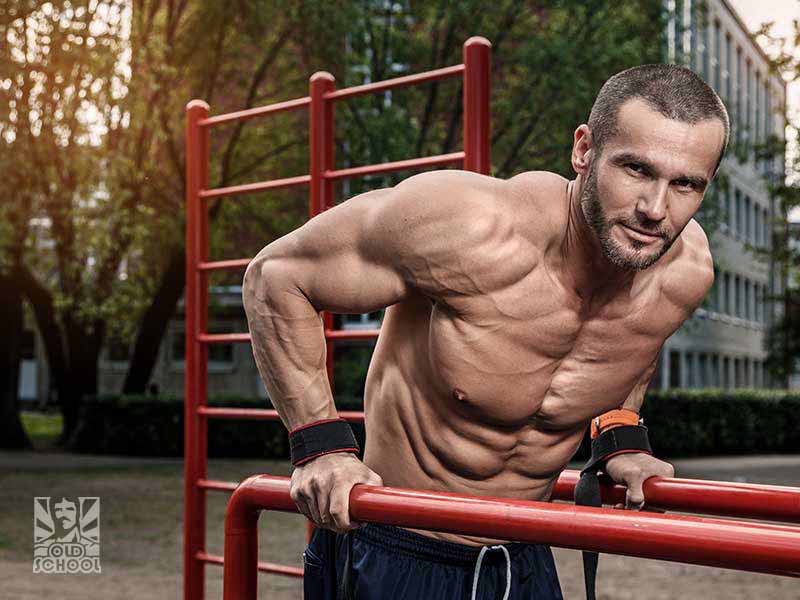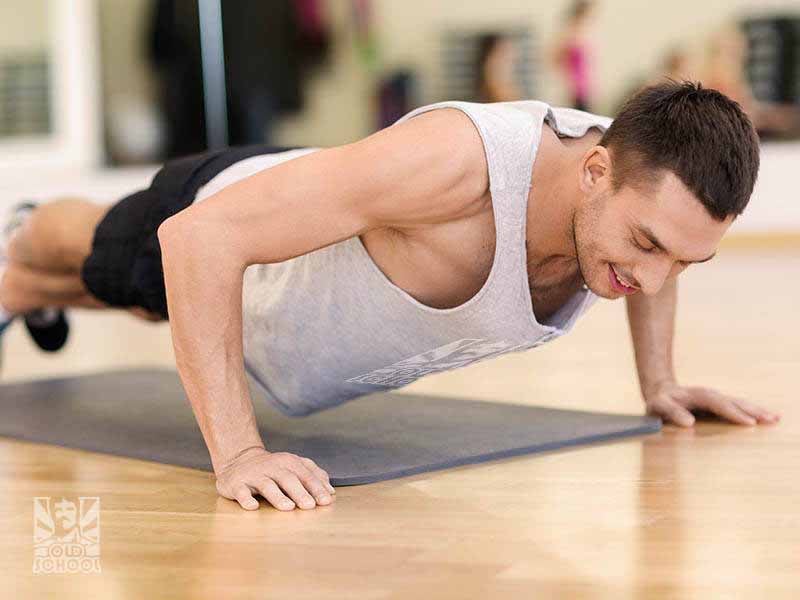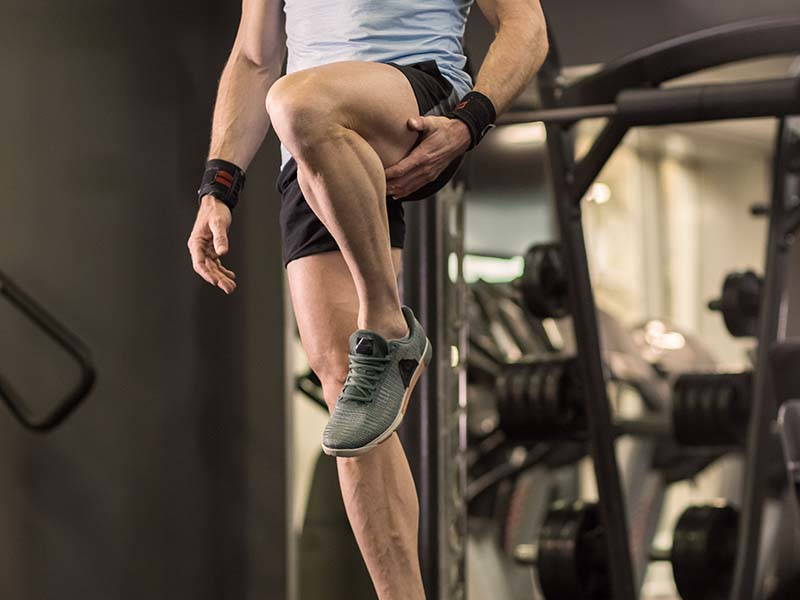
Bodyweight Workout: A 2020 Guide for Best Results
Key Takeaways
- Bodyweight training is a convenient alternative to traditional gym workouts. When done right, it can help improve and maintain your overall fitness.
- Cardio bodyweight exercises, such as mountain climbers and plyo push-ups, can skyrocket your heart rate and throw your metabolism into overdrive. These movements can be more effective for fat loss than steady-state cardio.
- If you’re a beginner, bodyweight training may help you build mass and strength. Advanced lifters, on the other hand, can do these exercises to maintain lean mass and improve their physical endurance.
- Get creative with your bodyweight workouts by adding kettlebells, dumbbells, resistance bands, jump ropes, and other accessories to the mix. This way, you’ll keep your muscles guessing and force them to work harder.
- In addition to its fitness benefits, bodyweight training may improve cardiovascular health, flexibility, balance, and range of motion in people of all ages and fitness levels.
Are you spending hours in the gym? Or perhaps you can’t afford a gym membership? The good news is, you can always work out at home. Don’t let a lack of time or equipment keep you from reaching your fitness goals & new year resolutions!
When done right and combined with a balanced diet, bodyweight training can be just as effective as traditional gym workouts. From pistol squats and push-ups to mountain climbers, there are countless exercises you can try.
Some build power and strength, while others torch fat and ignite your metabolism.
Depending on your fitness level, you can perform an advanced bodyweight workout or one that incorporates basic movements. If you choose the latter option, try different variations of your favorite exercises as you progress.

Let’s take bodyweight squats, for example. This movement is so simple that even a kid can do it. For a more challenging workout, try the single-leg squat, the Bulgarian split squat, or the pistol squat.
If you’re trying to get leaner, experiment with plyometric squats. The jump squat and other cardio bodyweight exercises will skyrocket your heart rate and burn massive calories.
But how effective are the best bodyweight workouts compared to gym exercises? Can you really get ripped to the bone or build mass? Keep reading to find out!
Do Bodyweight Exercises Build Muscle?
A well-thought bodyweight workout can help you build mass up to a point. It won’t turn you into the Incredible Hulk, but it’s ideal for strength and conditioning routines. If you’re a newbie, you can expect to put on muscle.
From a health perspective, bodyweight exercises are just as beneficial as traditional strength training. But we’ll discuss that later.

Let’s start with a recent study published in Environmental Health and Preventive Medicine, which assessed the effects of low-intensity bodyweight training on older adults.
Subjects who used this approach experienced an increase in leg strength and improved motor function in a relatively short time.
In another study conducted on elderly people, those who performed bodyweight exercises reported significant improvements in lower limb muscle force and power.
Furthermore, bodyweight exercises have been shown to:
- increase muscle mass
- build strength
- improve fat distribution.
It’s interesting to note that in one study, bodyweight training activated the majority of the leg muscles to the same extent as bilateral leg presses.
As you might have guessed, these studies involved basic exercises targeted at seniors. Yet, they were effective. Now imagine what you could accomplish with an advanced bodyweight training routine!
While this training method has its limitations, it does offer several benefits.
Bodyweight workouts can improve your balance, flexibility, and range of motion while burning fat. On top of that, beginners can build muscle and strength with exercises that require no equipment.
Another advantage of bodyweight training is that it makes it easier to hone your technique and prevent injuries. For example, if you perform bodyweight squats with perfect form, you’ll likely do barbell squats correctly as well.
Why Bodyweight Training Works
All strength training programs have one thing in common: they require a gradual increase in the stress placed on the body during exercise. This concept is known as progressive overload and plays a key role in hypertrophy.

Whether you want to build mass, gain strength, or both, you must constantly challenge your muscles to prevent them from adapting to training. This can be done in several ways, including:
- Increase the resistance
- Complete more reps or sets
- Decrease rest time between sets
- Work out more often (increase training frequency)
- Add new exercises to your routine
Muscles grow bigger and stronger in response to a training stimulus. If you do the same workouts over and over, your body will eventually adapt. That’s why it’s crucial to force your muscles to do more than they’re used to.
The result is an increase in mass, strength, power, and endurance.
For example, when you’re at the gym, you can gradually increase the load to keep your muscles guessing. If you typically do barbell squats with 200 pounds, add an extra 20 pounds during each workout to make it more challenging.
The Convenience of Bodyweight Training
When you work out at home, you don’t have access to a barbell and weight plates (unless you have your own home gym).
However, you can still increase the demands you place on your body by trying different squat variations or adding a few extra reps or sets to the mix. Over time, this approach can help you get bigger and stronger.

If you’re the skinny type, you might be thinking that your bodyweight isn’t enough for this kind of training. Not really. According to a study in the Journal of Applied Physiology, muscle growth can occur using as little as 30% of the maximum load you can lift.
Again, this depends largely on your fitness level.
A beginner, for instance, will get significantly better results from bodyweight training than a pro bodybuilder. Experienced athletes, though, may use bodyweight exercises to main lean mass and overall conditioning.
If you’re on the heavier side, you may have trouble doing push-ups and other bodyweight movements. But you can modify most exercises to accommodate your weight.
For example, you could do kneeling push-ups instead of regular push-ups.
Skyrocket Your Metabolism with Bodyweight Exercises
Bodyweight exercises may not be the best choice for packing on mass, but they torch massive calories. Due to their intense nature, they raise your heart rate and boost your metabolism, so you’ll keep burning calories for hours after finishing your workout.
The key is to choose the right moves for your goals and stick to your training routine. The higher the intensity, the more calories you’ll burn.

A research article published by the American College of Sports Medicine discusses the benefits of high-intensity bodyweight training for fat loss.
As its authors point out, this workout method can provide an adequate training load as long as the intensity is high enough for both aerobic and resistance exercises.
What makes it so effective is its dynamic nature, which elevates your heart rate, as well as the short breaks between sets. This approach ensures maximum fat burning in minimal time.
Furthermore, bodyweight exercises — especially when used as part of a circuit training routine — increase the maximum rate of oxygen consumption (VO2 max), a marker of cardiorespiratory health.
In other words, this training method may improve cardiovascular health and physical endurance.
But that’s not all.
Bodyweight Workouts May Reduce Risk of Diabetes
According to a study cited in the above review, bodyweight training may help reduce insulin resistance, which in turn, can lower diabetes risk. Working out for as little as 8 minutes per week at an intensity higher than 100% VO2 max may improve insulin response.

For best results, create a bodyweight workout plan consisting of exercises that meet the following criteria:
- Engage all major muscle groups
- Can be easily modified to increase or reduce training intensity
- Are safe and appropriate for your fitness level
- Allow you to use common items from around the house, such as a bench, chair, or stairs
- Can be performed with little or no rest in between sets or exercises
Also, make sure your workout is balanced overall.
For example, it’s not recommended to only perform exercises that target your arms or back muscles, such as push-ups and pull-ups. This can lead to strength and muscular imbalances.
We all have a friend or two with chicken legs… Don’t be THAT friend!
Discover the Best Cardio Bodyweight Exercises
As you might have guessed, some bodyweight exercises are better than others for fat loss. Sure, you can torch fat with push-ups, Russian twists, glute bridges, and other strength movements, but you’ll get faster results by using a different approach.
Ideally, combine strength and cardio bodyweight exercises. Or dedicate a day or two to cardio training every week, depending on your goals.
Here are some great fat-burning movements that require no equipment:
- Step-ups with knee raises
- Standing long jumps
- Squat jumps
- Tuck jumps
- Box jumps
- Jumping jacks
- Jumping lunges
- Plank jacks
- Mountain climbers
- Burpees
- Skaters
- Flutter kicks
- Plyo push-ups
- Squat thrusts
- Crawling
A cardio bodyweight workout can include anywhere from two or three to 10 or more exercises. Intensity is the key.

For example, you could try the following circuit:
- Plyo push-ups: 20 reps
- Burpees: 20 reps
- Mountain climbers: 20 reps
- Squat jumps: 20 reps
- Jumping lunges: 20 reps
Better yet, try HIIT or Tabata for maximum fat burning. As mentioned earlier, cardio bodyweight exercises will skyrocket your heart rate, which makes them ideal for high-intensity interval training.
4-Minute Bodyweight Tabata Workouts
Tabata is clinically proven to burn fat and improve cardiorespiratory endurance. Compared to steady-state cardio, it provides better results in less time. A typical workout takes just 4 minutes and alternates between high-intensity exercise and short breaks or lower intensity training.
According to the American Council on Exercise, Tabata may raise the basal metabolic rate for up to 48 hours after training. Therefore, it’s one of the most efficient ways to burn fat.
Tabata and bodyweight training are a perfect match. Try these workouts — and remember to move as quickly as you can:
- Plyo push-ups: 20 seconds
- Rest: 10 seconds
- Mountain climbers: 20 seconds
- Rest: 10 seconds
- Plank jacks: 20 seconds
- Rest: 10 seconds
- Russian twists (at a fast pace): 20 seconds
- Rest: 10 seconds
- Squat thrusts: 20 seconds
- Rest: 10 seconds
- Plyo push-ups: 20 seconds
- Rest: 10 seconds
- High-knees: 20 seconds
- Rest: 10 seconds
- Plank jumps: 20 seconds
- Rest: 10 seconds
If you’re just getting started, choose just two or three exercises, such as plank jacks and burpees.

Perform one exercise at high intensity for 20 seconds, rest for 10 seconds, do the second exercise for 20 seconds, rest for 10 seconds, and repeat for 4 minutes.
Here’s another bodyweight Tabata workout you may try:
- Squat jumps: 20 seconds
- Rest: 10 seconds
- Box jumps: 20 seconds
- Rest: 10 seconds
- Burpees: 20 seconds
- Rest: 10 seconds
- Mountain climbers: 20 seconds
- Rest: 10 seconds
- Plyo push-ups: 20 seconds
- Rest: 10 seconds
- Skater hops: 20 seconds
- Rest: 10 seconds
- Box shuffles: 20 seconds
- Rest: 10 seconds
- Plyo push-ups: 20 seconds
- Rest: 10 seconds
Get Creative with Your Routine
The above exercises — and others — don’t require any equipment. However, this doesn’t mean you can’t improvise.
Most folks have a bunch of stuff around the house, from jump ropes and wooden boxes and old dumbbells. Any of these items can be incorporated into a bodyweight workout.
If you don’t have any equipment, you can buy basic accessories for just a few bucks. Let’s see a few examples:
- Resistance bands
- Kettlebells
- Adjustable dumbbells
- TRX or other suspension training kits
- Battle ropes (depending on how much space you have available)
- Wooden box
- Jump rope
- Heavy punching bag
- Pull-up bar
- Balance trainer
- Medicine balls
- Ab wheel
- Step platform
Kettlebells, for instance, are ideal for dozens of exercises and can take your workouts to a whole new level. Some models cost as little as $12. A single 35-pound kettlebell is more than enough for beginners.

So what can you do with this versatile piece of equipment? Here are some of our favorite kettlebell exercises:
- Kettlebell swings
- Snatches
- Pistol squats
- Goblet squats
- Farmer’s walk
- Single-arm rows
- Single-arm floor press
- Reverse lunges
- Russian twists
- Turkish get-ups
- Clean and press
- Single-arm deadlifts
- Single-leg deadlifts
- High pulls
- Overhead presses
Many of these exercises don’t require a kettlebell or a dumbbell, but using one will add resistance and force your muscles to work harder.
For example, a 2010 study conducted by the American Council on Exercise required subjects to perform a 20-minute kettlebell snatch workout.
The study participants burned about 272 calories on average, not counting the additional energy expenditure resulting from the anaerobic effort.
As the researchers note, most subjects torched approximately 20.2 calories per minute, which is a lot more compared to traditional cardio and strength workouts. That’s pretty much the same as running a 6-minute mile pace!
What’s the Best Bodyweight Workout for Mass and Strength Gains?
Contrary to popular belief, bodyweight training doesn’t limit your options in terms of exercise variety.
Although you may not be able to do the same exercises you’d do in a gym, there are plenty of other movements you can try. Some are just as good as or even better than traditional gym workouts.
If you’re trying to build mass and strength, choose exercises that engage the major muscle groups. Use slow, controlled motion and focus on the muscles targeted during your workout.

Then try more challenging variations or add new exercises to the mix.
Push-ups, for instance, can be performed in dozens of ways. Depending on your fitness level, try the following variations:
Beginner push-ups:
- Wall push-ups
- Standard push-ups
- Single leg raised push-ups
- Push-ups on the knees
- Elbow push-ups
Intermediate push-ups:
- Single leg pike push-ups
- Alligator push-ups
- Knee-to-chest push-ups
- Diamond push-ups
- Push-ups with the feet elevated
Advanced push-ups:
- Handstand push-ups
- Pushup jacks
- Wide push-ups
- Side-to-side push-ups
- Triple clap push-ups
Each version targets different muscles.
The diamond push-up, for example, is particularly effective for the triceps, but it also targets your pecs, delts, and biceps.
The single-leg push-up, on the other hand, engages your obliques and lower chest muscles as well as the triceps, anterior delts, biceps, and upper chest muscles.
The same goes for bodyweight squats. Some squat variations are best for building strong quads, while others will shape your glutes and hamstrings.

You can try the sumo squat, the goblet squat, Bulgarian split squats, and more.
When creating a bodyweight workout plan, follow the same rules that apply to traditional gym exercises.
Split your routine to target different muscle groups on different days, watch your form, take one or two days off training each week. Most importantly, eat for your goals, whether it’s fat loss or hypertrophy.
Get the Most Out of Your Bodyweight Workout
As you can see, bodyweight training is anything but boring.
From handstand push-ups and lunges to box jumps, there are hundreds of different exercises that require no equipment. The key is to continually increase the challenge and keep your muscles guessing.
Above all, be consistent and stick to your training routine. Since you can do these exercises anytime, anywhere, you have no excuse to skip your workouts.

You don’t need a fancy gym to get your workout done. Put in time and effort, and the results will follow.
Looking for some inspiration? Check out our guide to best home workouts and exercises for all fitness levels!
If you still have doubts, see how free weights compare to gym machines and consider the advantages of working out at home.
What have been some of your fitness achievements in 2019? What are your goals for 2020? Do you ever use bodyweight workouts or are interested in trying? Share your experiences and any tips you have in the comments section below!








